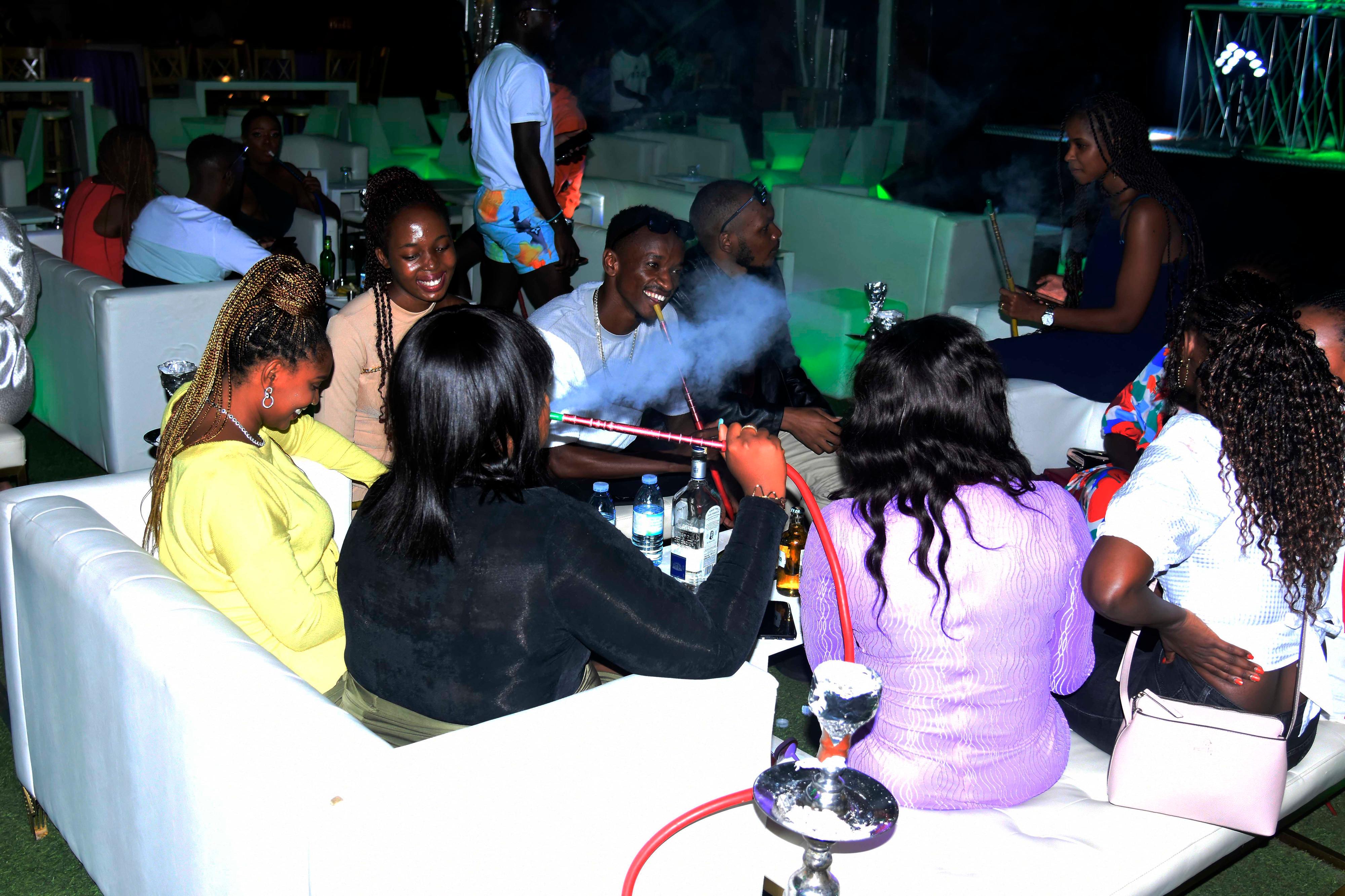Prime
After dark: The always evolving Kampala nightlife

Revellers at one of Kampala’s hangout spot. PHOTO | ISAAC KASAMANI
What you need to know:
- Into the night. Over the years, Kampala’s nightlife has undergone a significant transformation, witnessing numerous rebrands, closures, and openings. In the past, specific days were well-known for a night out, and the venues that hosted these revelers were limited, which guaranteed a certain level of attendance, writes Patrick Ssentongo.
The optimism of the newly freed country fueled Kampala’s vibrant nightlife in the early years of independence. Nightclubs, dancehalls, and bars sprung up across the city, drawing in both locals and expatriates.
Iconic establishments like White Nile in Katwe, Kololo Club, and Suzanna in Nakulabye were the favourite haunts of the city’s elite and political class, offering live music, dance floors, and an air of sophistication.
Nightlife during this time period was characterised by a fusion of traditional and contemporary elements, with live bands playing a wide variety of music to create a distinctive sound that embodied the post-independence spirit.
During this time, nightlife was a reflection of the changing cultural and political landscape of Uganda.
It was an era when the world was introduced to the vibrant rhythms of Ugandan music, thanks to artists like the legendary Elly Wamala, who graced venues such as the Sheraton Hotel, then known as the Apollo Hotel.
His music captured the hopes and dreams of the people, and his performances, along with those of other artists in his league, became an integral part of the city’s nightlife.
The 1970s and 1980s brought turmoil, leading to the closure of many venues.
Nevertheless, underground gatherings emerged as a means of escapism from the harsh realities of the time.
As Uganda emerged from these turbulent times, a new generation of entrepreneurs and entertainers arose, determined to reinvigorate the city’s nightlife.
The late 1980s and throughout the 1990s witnessed a resurgence of nightclubs and bars, and the city’s residents welcomed this revival with great enthusiasm, marking the recovery of Kampala’s nightlife.
The turn of the millennium brought the impact of globalisation, influencing the entertainment scene and the nightlife alike.
Nightclubs like Angenoir and Silk, which had originally opened in the mid-1990s, emerged as the new faces of nightlife in Kampala, reflecting changing preferences.
With modern interiors, urban DJs, and state-of-the-art sound systems, these establishments catered to a younger, more cosmopolitan crowd.
The New Face
Nightclubs used to symbolise a coming-of-age experience for every young adult, a venue where they created lasting memories, celebrated significant life milestones, and were considered an integral part of their youth culture. However, this mindset has shifted in recent times.
The idea of going out “on the piss” seems less appealing, and alternatives to nightlife offerings have become increasingly prevalent.
People now know what they like and are more willing to listen to exactly that, which has influenced the traditional nightlife scene.
Nightclubs that relied on a one-size-fits-all approach to entertainment lost their appeal. Today, clubs invest in market research to understand their audience’s preferences and schedules.
Market expectations have risen, and people demand to know what kind of music and experience they can expect. Venues are now expected to invest more in the quality of music they play and the services they offer to earn respect as credible establishments.
Increased expectations are the main factor driving this change. People are no longer content to spend their hard-earned money in a dimly lit room, drinking overpriced, mediocre drinks, and listening to generic music. They want more.
The current evolution of nightlife underscores the importance of providing guests with a unique and immersive experience. While the drinking culture in Kampala remains robust, there is a growing desire for a change in how it’s enjoyed. The appetite for clubbing has not diminished, and nightclubs are not becoming obsolete.
However, according to revellers interviewed by the Daily Monitor, there’s a growing expectation for more from these establishments.
According to a 2016 survey by Heineken, 75% of millennials limit their drinking on nights out. When they do drink, 45% prefer higher-quality drinks, emphasising the desire for a quality experience over quantity.
Evidently, the number of nightclubs has declined due to the increase in alternative options for dancing and enjoying drinks. Some have closed, while others, like Guvnor, which offers a comprehensive experience, continue to thrive. In recent years, venues falling under the nightlife umbrella, such as lounges with their unique concepts and theme nights, have gained popularity.
Kololo, one of Kampala’s upscale suburbs, is a leading hub for these bars and venues. The strategic location of Acacia Avenue, where most of these spots are situated in Kololo, attracts patrons from neighbouring suburbs who feel safe hanging out there due to its proximity to the city centre and residential areas. The roadsides and sidewalks of Acacia serve as parking spaces for revellers.
Cask Lounge, located at Plot 37 along John Babiha Road, is among those redefining the lively nightlife on Acacia Avenue in Kololo. Cask is a popular hangout for young people from various city university campuses and middle-class corporates, drawing them in throughout the week.
Benitah, a second-year business student at Makerere University Business School (MUBS), shared her love for the venue during a “Tequila Tuesday” theme night. She mentioned the vibrant deejays and hosts as the reasons for her visit. “Even though it’s a weekday, I decided to join in and enjoy Fem DJ’s fantastic music,” she says.
Her friend, Vicky, enjoys sitting, drinking, and chilling at lounges like Cask, which offer more seating than dancing space. Such venues focus on the overall experience, a feature that nightclubs often lack.
These venues attract local celebrities who mix and mingle with their fans. The venue management has hired marketing and publicity teams to carefully plan their experiences.
Furthermore, lifestyle events have become a defining feature of Kampala’s nightlife. Events like school sports leagues, Blankets and Wine, Roast and Rhyme, and others offer exceptional production and music. Though they do not happen frequently, these events provide a unique nighttime experience.
The prevalence of smartphones and social media platforms has transformed how events and venues are promoted and tickets are sold, relying on digital marketing and ticketing platforms to reach a broader audience.
The physical look and structure of venues have become integral to millennial nightlife culture. People seek spaces with clear backgrounds for capturing moments and well-equipped washrooms for selfies.
These features help venues stand out and attract visitors. Social media has revived struggling venues and exposed the shortcomings of lesser-known ones, impacting patrons’ decisions.
The Stay Home, Kafunda Culture
Accessibility through online platforms has transformed the nightlife industry by providing easy access to music from around the world, reducing the need to leave home.
This has led to the evolution of people’s musical preferences, with more individuals opting for indoor entertainment, leading to the rise of trends like house parties and local “Kafunda” gatherings.
“Kafundas” are small, informal local bars in residential areas that offer a relaxed atmosphere for patrons.
They often feature live music and local DJ sets, attracting both young and older generations looking for an authentic and intimate nightlife experience away from the known city hangouts.
These new trends became more relatable during the COVID-19 pandemic when people were deterred from movements and popular hangouts closed. People resorted to these, offering a closer connection with area code mates.
Additionally, these same spaces allow individuals to reduce costs associated with travelling to larger nightspots located at a distance. Moreover, the prices of alcohol in the local “Bufunda” establishments are typically slightly lower than those in mainstream bars.
These local venues also provide a layer of protection against unforeseen incidents, such as accidents that can happen while travelling to and from mainstream nightspots located outside their neighbourhood.
What does the future hold?
As we look to the future, the changing face of Kampala’s nightlife appears set to continue evolving. The city’s growing middle class, coupled with a fast-growing entertainment sector, is likely to contribute to the ongoing transformation. With the emergence of innovative concepts, nightlife is poised to adapt and thrive in the face of challenges.
The pressure is now on venues. People are no longer willing to accept the average. They want new concepts, innovative presentation, top-level music, and amazing production, and they want it done consistently. Venues will have to work hard to maintain their reputation and credibility, but the age of the nightclub is definitely not over.
Kampala’s evolving nightlife has not been without its challenges, and they will always be, even in the future. Issues related to noise pollution, security, and alcohol regulation have been topics of concern for the government and the public.
Noise complaints from residential areas near nightspots have led to stricter regulations on operating hours and noise levels, impacting some establishments.
Stakeholders in the nightlife industry need to address these issues. As it has for decades, the city’s nightlife reflects the spirit and aspirations of the Ugandan people, offering an ever-changing, vibrant, and dynamic experience that evolves with the times.
Kampala’s nightlife is more than just entertainment; it’s a reflection of the city’s past, present, and future.





